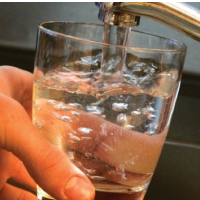L.A. Wants to Clean and Drink Groundwater at a Superfund Site

Faced with having to pay more very soon for scarce and endangered imported water, the city of Los Angeles has finally decided to try to contain and clean up the poisoned groundwater under the San Fernando Valley, and drink that instead.
The Los Angeles Department of Water and Power (LADWP) wants to test the water at 26 sites in the northern suburb and figure out a) what’s poisoned, b) what the poisons are, c) how it got there and d) where it might be going, before building the world’s largest water treatment center on top of a Superfund site.
The department would like to start construction on two plants, costing between $600 million and $800 million, in five years. It faces a few hurdles. Public sentiment has brought down other plans to treat water—a “toilet to tap” campaign killed a sewage treatment proposal in the ‘90s—although that one had a disgust factor missing from this one.
What this plan has working against it, besides the ratepayer costs and questionable policy choices, is a level and scope of toxicity that gives even the LADWP pause. “The ongoing inattention to identifying the sources of contamination and exercising appropriate, timely remedial actions has led to contamination threatening all of LADWP’s major well fields,” the department wrote in an overview (pdf) of contamination in the San Fernando Valley Groundwater Basin (SFB).
The basin is 175 square miles. Around 25% of it is considered too polluted to drink, but further explorations may reveal the percentage is upwards of 50%. As of June 2012, LADWP had 115 wells in the SFB of which 57, half of its pumping capacity, had been inactivated due to contamination. And the department wasn’t crazy about the water quality in the good ones.
The basin earned its Superfund status through decades of ill-advised handling of toxic chemicals associated with the hearty defense industry, industrial plants, auto repair shops, unlined landfills, dry cleaners and agricultural enterprises. Exposed to the elements, these chemicals seeped into the aquifer.
Chemicals that are present in abundance include trichloroethylene (TCE), identified by the U.S. Environmental Protection Agency (EPA) as being linked to liver cancer, and perchloroethylene (PCE), which can affect the nervous system and cause kidney and liver damage.
Efforts to identify and clean up the widespread pollution over the decades have moved at a glacial pace. Despite a Superfund declaration in the mid-1980s, the LADWP admits that one of the “obstacles” it faces in halting the spread of contamination, much less cleaning it up, is that, “Pollutant sources remain largely unknown.”
–Ken Broder
To Learn More:
LADWP to Build Groundwater Treatment Plants on Superfund Site (by Louis Sahagun, Los Angeles Times)
DWP Looking at New Groundwater Cleanup Projects in the San Fernando Valley (by Rick Orlov, Los Angeles Daily News)
Superfund Sites San Fernando Valley (All Areas) (U.S. Environmental Protection Agency)
San Fernando Groundwater Basin Contamination (Los Angeles Department of Water and Power) (pdf)
- Top Stories
- Controversies
- Where is the Money Going?
- California and the Nation
- Appointments and Resignations
- Unusual News
- Latest News
- California Forbids U.S. Immigration Agents from Pretending to be Police
- California Lawmakers Urged to Strip “Self-Dealing” Tax Board of Its Duties
- Big Oil’s Grip on California
- Santa Cruz Police See Homeland Security Betrayal in Use of Gang Roundup as Cover for Immigration Raid
- Oil Companies Face Deadline to Stop Polluting California Groundwater





